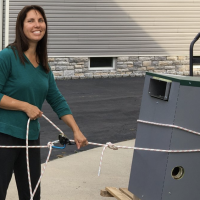Near Boiler Piping Question
I attempted doing a search but a number of promising posts on this site get an error message. Maybe they are expired because of age?
So for a CI boiler I am trying to determine what kind of pipe material is appropriate for the near boiler. Some articles say copper then some say black pipe for a certain distance. Then switch directly to copper but some want a separation, my mind is blank on the term for this coupling.
So I would appreciate your assistance.
Thanks!
Comments
-
Basically: Black pipe above the water line. Black pipe or copper below the water line. I'm assuming you are talking about steam.
NJ Steam Homeowner.
Free NJ and remote steam advice: https://heatinghelp.com/find-a-contractor/detail/new-jersey-steam-help/
See my sight glass boiler videos: https://bit.ly/3sZW1el0 -
Actually, I think you're talking about hot water systems since you've asked questions about radiant floor heating and new hot water boilers. In which case copper is commonly used for near boiler piping.
Our 2 hot water boilers have all copper near the boilers, then transition into the old large-diameter steel pipes that run to the original cast iron radiators. I think the "separation coupling" you're talking about is a dielectric union, which is sometimes needed to prevent galvanic corrosion between dissimilar metals in the presence of oxygen-bearing water. But in the case of closed hydronic heating systems where the oxygen eventually gets driven out or gets quickly converted into iron oxide, it seems the dielectric unions aren't necessary. All our copper-to-steel pipe joints are simply threaded couplings with pipe dope, and apparently that's standard practice.
Dielectric unions are needed in DHW systems, though, because the unlimited supply of oxygen in the incoming fresh water will cause galvanic corrosion.
0 -
-
It often depends on how many components that are being piped and what they are made of. Not to mention the preference of the installer.
A common practice is to have black pipe installed close to the boiler and then have the piping transition to copper and or pex. This can often help with supporting the piping and the structural integrity. This transition can also help with the prevention of electrolysis as dissimilar metals are introduced, ie. black pipe to brass valve to copper, installed one after the other serving the same line.
0
Categories
- All Categories
- 87.3K THE MAIN WALL
- 3.2K A-C, Heat Pumps & Refrigeration
- 61 Biomass
- 427 Carbon Monoxide Awareness
- 119 Chimneys & Flues
- 2.1K Domestic Hot Water
- 5.8K Gas Heating
- 115 Geothermal
- 165 Indoor-Air Quality
- 3.7K Oil Heating
- 76 Pipe Deterioration
- 1K Plumbing
- 6.5K Radiant Heating
- 395 Solar
- 15.6K Strictly Steam
- 3.4K Thermostats and Controls
- 56 Water Quality
- 51 Industry Classes
- 49 Job Opportunities
- 18 Recall Announcements

